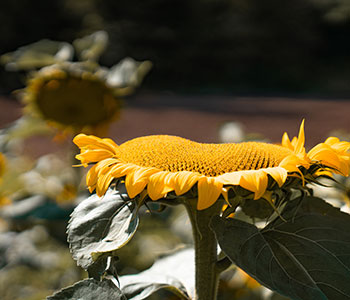
The sunflower – a mini ecosystem for everyone's garden
Sunflowers are best known for the large fields you see when driving past them – their heads facing the sun in unison, grown by farmers for the production of oil, seeds or bird feed. But they are much more than just a crop.
July 2025
Are you one of the lucky ones who, as a child, picked the unripe white sunflower seeds from the flower head of the giant plant in the garden and snacked on them? Do you remember that very special taste? Sweet, nutty, slightly sour – simply delicious! These impressive composite flowers have become rare in private gardens. Yet there are many good reasons to reintroduce them.
The common sunflower (Helianthus annuus) can grow up to three metres high – it usually reaches one metre without any difficulty. Not every soil is ideal, but this robust plant also thrives in pots – and therefore on patios and balconies. The yellow ray florets surround up to 1,500 small brown tubular florets, from which the seeds develop after pollination.
The sunflower is an annual plant, but with a little luck it will self-seed if the ripe seeds are not harvested. Especially on humus-rich, open soils, one or two plants often sprout spontaneously the following spring. It does not like heavy clay soils, which is why we always have a sunflower in a pot in our garden. Not only is it pleasing to the eye, but it is also a small ecosystem in itself.
1. An insect hotspot 🐝
A single sunflower head consists of countless small flowers that constantly provide nectar and pollen. A single plant thus becomes a magnet for honey bees, wild bees, bumblebees and hoverflies. Sunflowers are only partially self-pollinating – around 20% – and therefore need a lot of external support.
2. Supporting pollination of neighbouring plants 🌱
Visitors that fly to the sunflower often pollinate neighbouring plants such as tomatoes, herbs or berries – a real win-win situation. Excellent!
3. Fostering biodiversity 🦋
Sunflowers attract not only bees and bumblebees, but also a variety of other insects: beetles, flies, wasps and butterflies. This means that a single plant acts as an important source of beneficial insects – even in the middle of the city.
4. Natural food source for birds and squirrels 🐦
After flowering, protein-rich seeds develop, attracting titmice, finches, sparrows – and, with a little luck, even squirrels. Therefore, leave the faded heads on the plant to provide these animal guests with a natural source of energy.
5. Microclimate & refuge 🌦️
The large flowers provide shade, reduce evaporation and offer protection for soil insects such as ladybirds and lacewing larvae, which also help to maintain a healthy balance. Sunflowers thus act as a vertical habitat that benefits both plants and animals.
6. A source for those with a sweet tooth 😋
Try the soft white seeds with your children – they will love them. Sunflower seeds are rich in healthy fats (50%, including linoleic acid/omega-6), protein (20%), vitamins (E) and secondary plant substances (magnesium & selenium, phytosterols, etc.).
7. A feast for the eyes 🌻
Sunflowers are simply beautiful!
It's not too late for this year. You can still sow these fast-germinating plants until mid-July. They will bloom until autumn; the seeds will probably not fully develop, but it's not always about that one thing.




